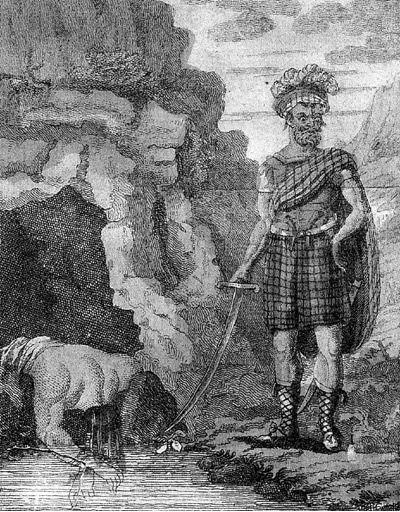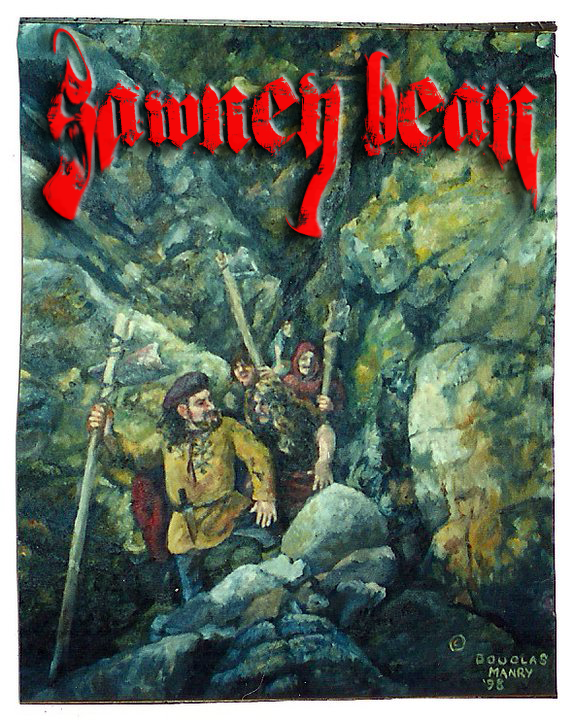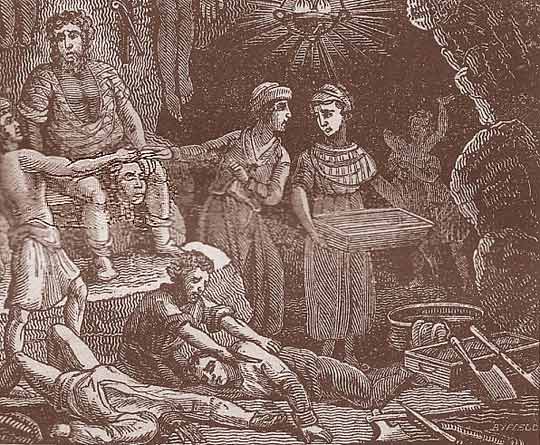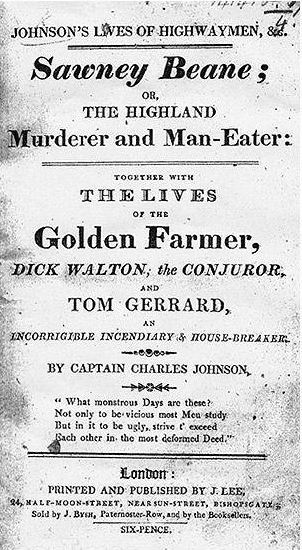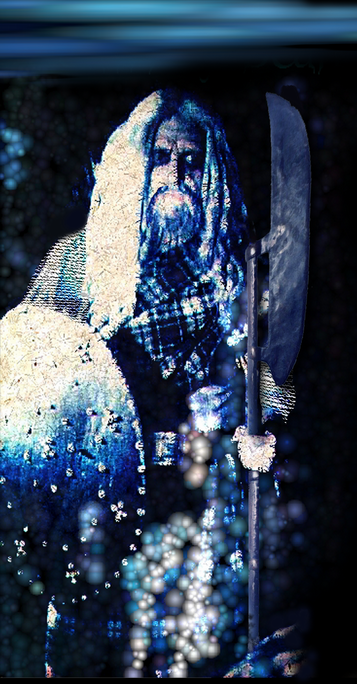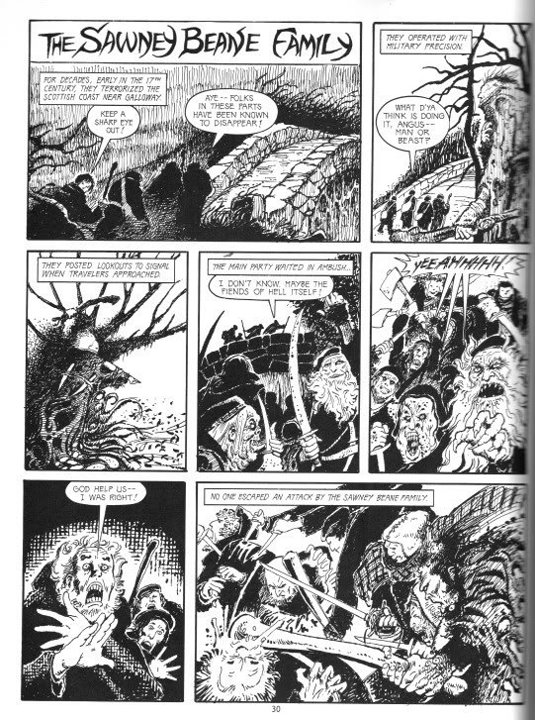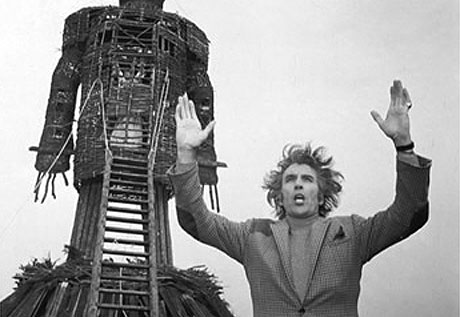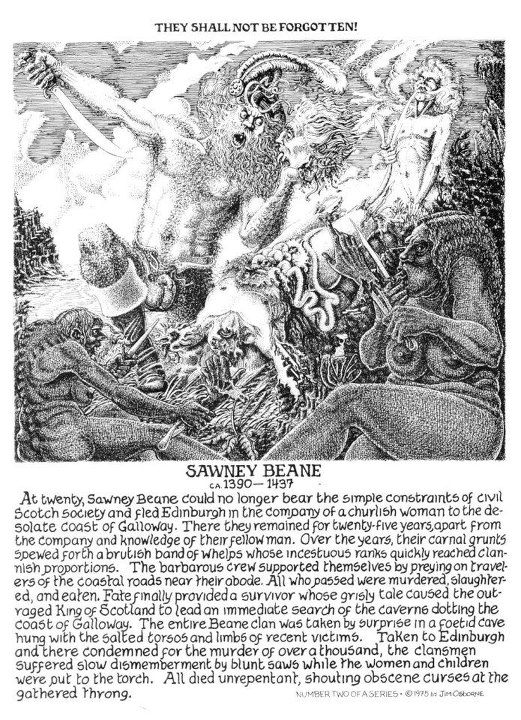IN THE LAIR OF THE CANNIBAL KINGby Tom Doran For 25 years Sawney Bean and his incestuously bred cannibal clan were reputed to have skulked about the barren shores of Galloway in the south west of Scotland. Venturing out from the depths of their cave to hunt for food – be it animal – or human. And in all that time, never once leaving a trace to give themselves away – until one fateful day. Or so the story goes. The tale of the Galloway Cannibal, taken for historical fact for centuries - and still believed by many to be true, seems to be nothing more than a fictional tale of terror - there has never been a single piece of evidence for his existence or the deadly deeds of his family. Why are people so interested in this character? What is so fascinating about him and his evil crimes that millions of people are drawn into the web of these flesh-eaters?
For those of you who don't know, the story relates how a poor, deprived child named Sawney (a nickname for Alexander - though Sawney was a very common generic name for any Scotsman, in the same way that "Paddy" - insulting to most Irishmen - came to be associated with a generic Irishman. At the time of the first published "history" of the cannibal, it was a name used often by the English in a similar derogatory way; in print and theater) was the son of a hedger and ditcher, somewhere outside Edinburgh - being a lazy creature, he ran off with a equally desperate woman and found themselves living in a cave on the coast of Galloway - there they hunted humans and raised a brood of children and grand-children - eating up the countryside for 25 years. A thousand victims it is said to have fallen to the monsters. One day the cannibals attacked a couple on horseback returning from a fair - and the rider got away (though his wife did not) to spread the alarm. Before anyone could say "cannibal" - the King himself showed up with 400 men and a pack of hounds. They found the clan - captured them all - then dragged them the considerable distance to Edinburgh - without any sort of trial the family of monsters, who now numbered 45, were put to death - men and boys hacked to pieces, while the woman burned alive. And in the nearby port town Leith for some reason. A complete and total lack of evidence points to this horrific and unique tale as just being a sensationalist, and frankly, anti-Scottish story - possibly created by the English to show the displeasure of many for what seemed to be the impending union of nations (the first mention of Sawney seems to be around 1701 - the Union was 1707) - though the talk of combining the nations has of course been long standing, and the Union of the Crowns that happened when James VI-I became kind of England, solidified those notions - and indeed those fears. James in fact, while putting down the Border Reivers admonished anyone who would even use the term "border". In his mind, the nations of Scotland and England (and Wales) were already united - though it took a century after James crossed the border to the south before the "buying" of the Union took place. As mentioned above it is more likely an English author would have used the name Sawney, than a Scot - and the derogatory nature of its use was certainly an English notion regardless of the origin of the name. The English and Scots had no love for each other - the English considering the Scots horrible barbarians who couldn't even speak English - so, pushing their contempt one step further into cannibalism seem not much of a stretch. The border area was notoriously dangerous at that time (or its recent-ish past in any event), and the rough coast was then rife with smugglers and buccaneers of all sorts. Tales of cannibals lurking in shoreline caves would certainly be to their benefit.
These events are always said to have taken place during the reign of James I of Scotland - the King who came south and started the "friendly" invasion of Scots (though some have conjectured it is James I of Scotland, and not James VI-I). James VI-I was an outspoken critic of witches, witchcraft and the supernatural, and the tale could easily be attributed to his reign because of this. This horrific story seems to fit right in with his holy purpose in life. Since James was the first Scottish king on the English throne, and viewed as having opened the floodgates for unwanted Scots of any variety, attributing it to his reign makes a bit of sense. However, there is no factual, documentary evidence relating to Sawney, or to any King named James being involved in any adventure even remotely similar. Court records have been gone over by others, and no mention has ever been found. The story conveniently states that there was no trial – just terrible retribution. However, there is no other corresponding written evidence and one would imagine there would be. Wouldn't a heroic tale involving the King of Scotland fighting an army of cannibals be documented in some fashion? And just as importantly, there is no local oral tradition - and no songs. There are no known family or personal histories - either from the families of supposed victims, nor any eye-witnesses to the sight of the cannibal family being dragged from Galloway to Edinburgh and then to execution in Leith. One would imagine that there would be many witnesses and resultant stories - sadly, there are none. The tale also relates that many innocents were tried (inn-keepers mainly), judged, property seized, jailed and executed - all unjustly convicted of crimes that the Cannibal King in fact had committed. But where is the evidence of that aspect of the story taking place? There is none. And why make such an assumption regarding other cases (none of which have been recorded) if the truth did not come to light after the fact? After Sawney and his family were captured. History has many witnesses - many variation of events, interpretations (for the most part) - but the tale of Sawney? It never changes - and that only happens with fiction.
There are indeed court documented cases of cannibalism in Scotland as late as the 16th century, and one would imagine that it may have happened in other places as well. It happens today. And there are many theories as to how this story could have become such a national bogey man for Scotland. Some think Sawney is really based on the story of Perth butcher turned cannibal, Andrew Christie - "Christie Cleek" - for which some minor, documentary evidence does exist. But that tale took place during the right of David II - but there are some similarities to Sawney. Christie was a butcher, and during a time of terrible famine (well documented), he took to the hills and hid out in the Grampian Mountains - there aligning himself with other, equally desperate folk - who turned to cannibalism purely to survive. They lived in mountain-side cave, and with a hook of Christie's own device, would pull travelers to their doom. Cleek is a Scots word for "hook" - so hence his name. A small army went after the group, quickly killing and capturing some, and dispersing the rest - Cleek himself vanished during the battle, and slipped into the mists of history. Though a nightmare fairy-tale, with a sort of early Poe-like revelatory ending - came into being, supposedly told to bad little children as a bedtime story! So, is the astonishing story of Sawney Bean true? It seems very unlikely – but science and modern evaluations of history have shown that it has often found ways of bringing to light the truth of even more bizarre tales and legends, so can say for sure? Perhaps some scrap of evidence will make itself known to us sometime soon. Or perhaps not. There are some people who believe they have identified Sawney Bean's cave (near Ballantrae); and it is so named on ordinance maps - but the cave is certainly too small to harbor a family of such legendary size for such a period of time - and the location of the cave, moved from the tale to this area is a direct result of the author S.R. Crockett, who wrote of Sawney in his novel The Gray Man. There's no other reason to believe this particular cave has any connection to Sawney or any other character who lived on human flesh - other than as a magnet for local tourism that is. And as terrible as the events of the story are, well, it is entertaining to believe such a nightmare tale might have really happened. Safely relegated as it is to centuries past. How content would we be if it was happening all around us today? History has many witnesses - writers of fiction, only one. Themselves. As a companion piece to the more informative Sawney article in this issue, I am also presenting the most famous published "history" of Sawney Bean. It is clearly derived, almost word for word, from various broadsheets that circulated in the early 18th century (the earliest one I have seen was from 1701). This one is by John Nicholson, and was originally published in 1843 in a collection entitled Historical and Traditional Tales Connected with the South of Scotland. It is clearly the most famous one today. The story has been handed down since then virtually unchanged, which while not unusual for a piece of fiction, is highly unusual and improbable for a piece of history. Even very ancient histories tend to have more than one version of events as new facts often come to light, or the value of speculative evaluations changes. But with Sawney? Not so. Unchanged. And here is that original tale of terror on which all Sawney tales are derived. The Tale of Sawney Bean and his Cannibal Clanby Tom Doran The following account, though as well attested as any historical fact can be, is almost incredible, for the monstrous and unparalleled barbarities that it relates; there being nothing that we ever heard of, with the same degree of certainty, that may be compared with it, or that shews how far a brutal temper, untamed by education, and knowledge of the world, may carry a man in such glaring and horrible colours. Sawney Bean was born in the county of East Lothian, about eight or nine miles eastward of the city of Edinburgh, in the reign of James I of Scotland. His father was a hedger and ditcher and brought up his son to the same laborious employment. He got his daily bread in his youth by these means, but being prone to idleness, and not caring to be confined to any honest employment, he left his father and mother, and ran away into the desert part of the country, taking with him a woman as viciously inclined as himself.
These two took up their habitation in a cave, by the seaside on the shore of the county of Galloway; where they lived upwards of twenty-five years, without going into any city, town or village. In this time they had a great number of children and grandchildren, whom they brought up after their own manner, without any notions of humanity or civil society. They never kept any company, but among themselves, and supported themselves wholly by robbing: being, moreover so very cruel, that they never robbed any one, whom they did not murder. By this bloody method, and their being so retired from the world, they continued for a long time undiscovered; there being no person able to guess how the people were lost that went by the place where they lived. As soon as they had robbed any man, woman or child, they used to carry off the carcass to the den, cutting it into quarters, they would pickle the mangled limbs, and afterwards eat it; this being their only sustenance: and not withstanding they were at last so numerous, they commonly had superfluity of this their abominable food, so that in the nigh-time they frequently threw legs and arms of the unhappy wretches they had murdered into the sea, at a great distance from their bloody habitation; the limbs were often cast up by the tide in several parts of the country, to the astonishment and terror of all beholders, and others who heard of it. Persons who have gone about their lawful occasions fell so often into their hands, that it caused a general outcry in the country round about; no person knowing what was become of their friends or relations, if they were once seen by these merciless cannibals. All the people in the adjacent parts were at last alarmed at such uncommon loss of their neighbours and acquaintance, for there was no traveling in safety near the den of these wretches: this occasioned spies to be frequently sent into those parts, many of whom never returned again, and those who did, after the strictest search and inquiry, could not find how these melancholy matters happened. Several honest travelers were taken up on suspicion and wrongfully hanged upon bare circumstances: several innocent inn keepers were executed, for no other reason than that persons, who had been thus lost, were known to have lain in their houses, which occasioned a suspicion of their being murdered by them, and their bodies privately buried in obscure places to prevent a discovery. Thus an ill-placed justice was executed with the greatest severity imaginable, in order to prevent these frequent, atrocious deeds; so many innkeepers, who lived on the western road of Scotland, left of their business, for fear of being made examples of, and followed other employments. This, on the other hand, occasioned many inconveniences to travelers, who were now in great distress for accommodation when they were disposed to refresh themselves and horses, or take up lodging for the night. In a word, the whole country was depopulated. Still the king's subjects were as much missed as before, so that it became the admiration of the whole kingdom how such villainies could be carried on, and the perpetrators not discovered. A great many had been executed, not one of them all made any confession at the gallows, but maintained to the last, that they were perfectly innocent of the crime for which they suffered. When the magistrates found all was in vain, they left off these rigorous proceedings, and trusted wholly to Providence, for the bringing to light the authors of these unparalleled barbarities when it should seem proper to the divine wisdom. Sawney's family was at last grown very large, and every one of it as soon as able, assisted him perpetrating their wicked deeds, which they still followed with impunity. Sometimes they would attack four, five or six, footmen together, but never more than two, if they were on horseback; they were, moreover, so careful, that not one whom they set upon should escape, that an ambuscade was set on every side to secure them, let them fly which way they would, provided it should ever so happen that one or more got away from the first assailants. How was it possible that they should be detected, when not one that saw them ever saw anybody else afterwards. The place which they inhabited was quite solitary and lonesome, and, when the tide came up, the water went near two hundred yards into their subterraneous habitation, which reached almost a mile underground; so that when people, who have been sent armed to search all the places about have passed by the mouth of the cave, they have never taken any notice of it, never supposing any human being would reside in such a place of perpetual horror and darkness. The number of people these savages destroyed was never exactly known; but it was generally computed that in the twenty-five years they continued their butcheries, they had washed their hands in the blood of at least a thousand men, women and children. The manner they were at last discovered was as follows: In the conflict the poor woman fell from behind him, and was instantly butchered before her husband's face, for the female cannibals cut her throat, and fell to sucking her blood with as great a gust, as if it had been wine: this done, they ripped up her belly, and pulled out all her entrails. Such a dreadful spectacle made the man make the more obstinate resistance, as he expected the same fate, if he fell into their hands. It pleased Providence while he was engaged that twenty or thirty who had been at the same fair, came together in a body; upon which Sawney Bean and his blood thirsty clan withdrew and, made the best of their way through a thick wood to their den. The man who was the first who had ever fell in their way, and came off alive, told the whole company what had happened, and shewed them the horrid spectacle of his wife, whom the murderers had dragged to some distance, but had not had time to carry her entirely off. They were all struck with stupefaction and amazement at what he related; they took him with them to Glasgow, and told the affair to the magistrates of that city, who immediately sent to the king concerning it. In about three or four days after, his majesty in person, with a body of about four hundred men, set out for the place where this dismal tragedy was acted, in order to search all the rocks and thickets, that, if possible, they might apprehend this hellish crew, which had been so long pernicious to all the western parts of the kingdom. The man who was attacked was the guide, and care was taken to have a large number of blood-hounds with them, that no human means might be wanting towards their putting an entire end to these cruelties. No sign of any habitation was to found for a long time; and even when they came to the wretches' cave, they took no notice of it, but were going to pursue their search along the sea shore, the tide being then out; but some of the blood-hounds luckily entered the Cimmerian den, and instantly set up a most hideous barking, howling and yelping; so that the king, with his attendants, came back , and looked into it: they could not tell how to conceive that anything human could be concealed in a place where they saw nothing but darkness; nevertheless, as the blood-hounds increased their noise they went further in, and refused to come back again; they then began to imagine something or other must inhabit there. Torches were immediately sent for, and a great many men ventured in, through the most intricate turnings and windings, till at last they arrived at that private recess from all the world, which was the habitation of these monsters. Now the whole body, or as many of them as could went in, and were all so shocked at what they beheld, that they were almost ready to sink into the earth. Legs, arms, thighs, hands and feet of men, women and children, were hung up in rows, like dried beef; a great many limbs laid in pickle, and a great mass of money both gold and silver, with watches, rings, swords, pistols and a large quantity of cloths, both linen and woolen, and an infinite number of other things which they had taken from those they had murdered, were thrown together in heaps or hung up against the sides of the den. Sawney's family, at this time, besides himself, consisted of his wife, eight sons, six daughters, eighteen grand-sons, and fourteen grand-daughters, who were all begotten in incest. Theses were all seized and pinioned by his majesty's order in the first place; then they took what human flesh they could find, and buried it in the sands; afterwards loading themselves with the spoils which they found, they returned to Edinburgh with their prisoners; all the country, as they passed along, flocked to see this cursed tribe. When they came to their journey's end the wretches were committed to the Tolbooth, from whence they were the next day conducted, under a strong guard to Leith, where they were executed without any process, it being thought needless to try creatures who were even professed enemies of mankind. The men were dismembered, their hands and legs were severed from their bodies, by which amputation they bled to death in a few hours. The wife, daughters, and grand-children having been made spectators of this just punishment inflicted on the men, were afterwards burnt to death in three separate fires. They all in general died without the least sign of repentance, but continued cursing and vending the most dreadful imprecations to the very last gasp of life. SAWNEY BEAN AND OTHER SCOTTISH MEDIA TERRORSby Tom Doran
Scotland has its fair share of monsters and myths - some of which have been made into films, or turned into novels, radio shows, theater pieces, and more. Scottish literature dealing with the supernatural is too long and detailed for this short article, but I can mention the likes of The Body Snatcher, Dr. Jekyll and Mr. Hyde, The Memoirs and Confessions of a Justified Sinner as just a very few examples of Scottish tales of terror that have made the leap from the written page to film and/or stage. The Loch Ness Monster has made it out of the lake and onto the screen - the earliest film being The Secret of the Loch, made in 1934; The Loch Ness Horror (1981); Loch Ness (1996); and the mockumentary Incident at Loch Ness (2004) - there are several others. Sawney Bean has been the subject of several films, though mostly indirectly related to the terrible tale - none have been period films that told the tale as written and commonly known. In 1972, the British film Death Line told a tale, based on Sawney, of workers on the London Underground, trapped beneath the streets, forgotten by all - till a generation of cannibals ultimately emerged to attack and eat commuters.
The Hills Have Eyes (1977) may be the most famous of these knock-offs - Director Wes Craven told his version of Sawney in contemporary America, and out in the deserts of southern California. It was a hit which spawned a direct sequel, and then two remakes decades later. There have been several other desert based Sawney films - Hillside Cannibals (2006) perhaps the worst of the lot - ineptly made, it is virtually incomprehensible - and not even the least bit fun. Evil Breed: The Legend of Samhain (2003) has a descendant of Sawney killing off American students (played by ex-porno actresses) in Ireland! The Canadian film Blood Clan (1990) tells the tale of a grand-daughter of Sawney, found alive after the clan is destroyed, transported to North America and brought up as a normal child - until her inherited blood and flesh-lust gets the better of her. Ravenous (1999) is another Sawney derivative - this time telling the tale of an isolated Army outpost in the American west of 1848. Into the snowbound fort stumbles a Scottish immigrant, who tells tales of cannibalism in the nearby mountains. An interesting and quirky film, it adds a bit of the real-life terrors of the Donner Party and mixes it with a Scottish cannibal. It's worth a viewing.
Most recently there is Sawney - Flesh of Man (2012) - another modern take, with Sawney and his deranged clan slaughtering and eating innocents - and driving a big black taxi around Scotland to snatch people off the streets and drag them back to degradation and death in the hills. There is also the award-winning animated short film - The True Story of Sawney Beane by Elizabeth Hobbs. Sawney has also appeared in plays and several novels, including perhaps the first one to do so: The Grey Man by S.R. Crockett (1896). One of the more recent being Lords of Darkness by Thomas Doran. Sawney has also made several comic book appearances over the decades as well, the first time in the 1950's.
Sawney has also found his way into an amusement "ride" at the Edinburgh Dungeons - a boat sails by and into Sawney's cave, where actors portraying Sawney and his family briefly terrorize poor paying tourists. One of the more interesting takes on our cannibal friend is an avant-garde modern dance piece, Last Orders, presented by the David Hughes Dance Company. Sawney has been the subject of many modern rock and roll songs as well by such bands as The Real Mackenzies, and many others. What's next for Sawney? Who can tell, but it's bound to be something weird and wonderful. A family of Scottish werewolves are on the loose in Dog Soldiers (2002) - fun, but obvious - and made in Luxembourg filling in for the Scottish Highlands, with just a very few establishing background shots actually filmed in Scotland.
Paganism is alive in modern-day Scotland in The Wicker Man (1973). Filmed in the lowlands of Scotland (Dumfries and other locations in Galloway - Sawney Bean territory), the film follows an innocent Christian policeman, lured to an isolated Scottish Isle in search of a missing girl. He finds much more than he expected, including the terrifying Wicker Man. The film has a huge reputation, but was cut to pieces by the British producer who thought the film was rubbish and it barely escaped into release. Some of the cut footage has since made it back into the film. The less said about the 2006 remake the better. An official "sequel" The Wicker Tree - made by the same director, has recently been released - and sadly vanished without a trace. The film however has recently spawned an arts festival called The Wickerman Festival. And though the founders of the Burning Man Festival may deny it, their immensely popular desert event was undoubtedly inspired by The Wicker Man film.
Making headlines in Scotland a few years ago was a horror film called Sacrificed (2008) - produced and directed by Edinburgh film-maker Keith Bradley. In order to fulfill his dreams of making a feature film, Keith took a deep plunge - and sold his flat to pay for the making of this modern day horror film of demonic possession. I don't know what's more frightening - his film or the fact that he sold his home to make it!
Other dark terrors are bound to come creeping out of Scotland in the near future - so keep your eyes peeled for them. |
